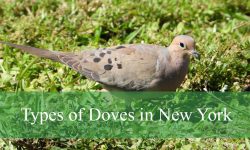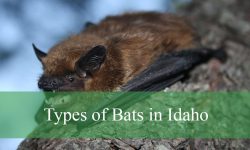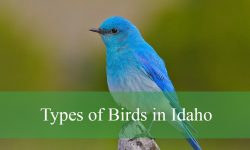California is home to a diverse array of moth species, each uniquely adapted to its specific habitat. From the lush coastal regions to the arid desert landscapes, various types of moths can be found fluttering about. One commonly spotted moth is the “Polyphemus Moth,” renowned for its sizable wingspan and distinctive markings. Additionally, the “Luna Moth,” adorned with its striking emerald green wings, is a captivating sight for many nature enthusiasts exploring the state. The intriguing diversity of moth species in California adds an enchanting layer to the rich tapestry of its natural ecosystem, inviting observers to delve deeper into the wonders of the nocturnal world.
Different types of Moths in California
White-lined Sphinx
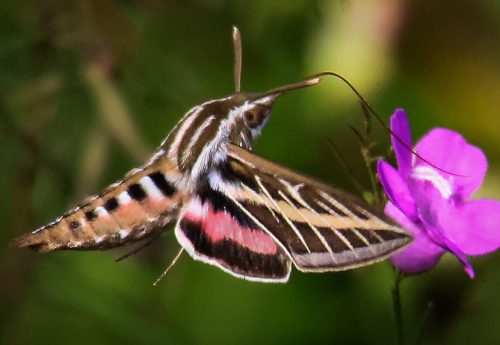
The White-lined Sphinx (Hyles lineata) has a robust, brown, hairy body with six characteristic white stripes that span two to three times its wingspans. They hover over flowers, their long proboscis sipping nectar, and are frequently confused with hummingbirds. Their favorite blooms are Petunia, Jimsonweed, and Cardinal Vine. Mass migrations take place prior to pupation, and females lay a large number of eggs in the spring, which occasionally causes caterpillar outbreaks.
Yellow-collared Scape Moth
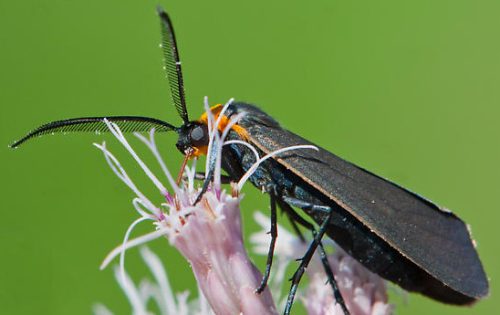
One of the most prominent pollinators in California’s parks, meadows, and forests is the Yellow-collared Scape Moth (Cisseps fulvicollis). They ward off intruders while visiting flowers, much like wasps. They are active from April to October, generating up to three generations a year, and have a wingspan of 1-1.5 in (2.5-3.8 cm). They build cocoons out of their own body hairs while hibernating as caterpillars.
North American Luna Moth
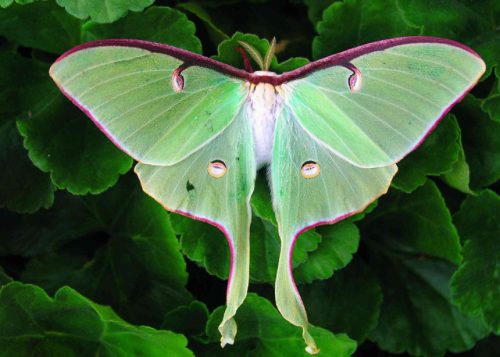
With its 4.5-7 lime-green wings, maroon borders, and eye-catching eyespots, the North American Luna Moth (Actias luna) is a noticeable sight in California. While females have larger abdomens for storing eggs, males have feathery antennae. They confuse bats’ echolocation with their long tails, and their eyespots startle predators. In warmer southern climates, they are visible all year round, but when they are active during breeding seasons, they release pheromones that males can detect from a distance.
Pale Beauty Moth
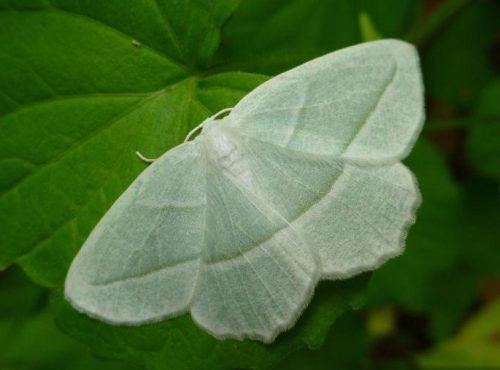
Campaea perlata, or Pale Beauty moths, have wingspans of 1.1-2. Their wings have thin, dark grayish lines that are accentuated with white, ranging from pale green to grayish white. They are drawn to outdoor lights and prefer deciduous woodlands. They are active in California from late spring to early autumn. Their life cycle consists of one generation in the north and two in the south. They overwinter as caterpillars on host trees, developing into reddish-brown to black pupae on stripped winter trees.
Rosy Maple Moth
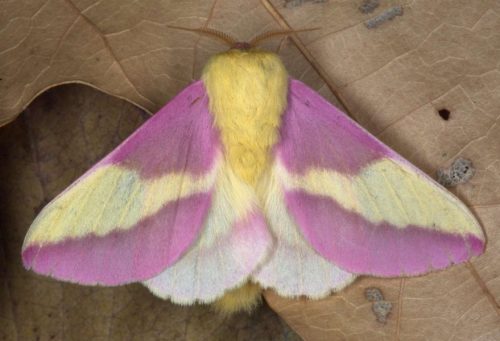
With wingspans of 1.25-2 and pink forewings with a yellow band and yellow hindwings, the Rosy Maple Moth (Dryocampa rubicunda) is quite impressive. They live in urban areas, suburbs, and deciduous forests in California, and are adored for their charm. They are found in April through September, blending in with maple seed cases. Before emerging in spring, caterpillars pupate underground for approximately a month, during which they consume sugar, silver, and red maples.
Forest Tent Caterpillar Moth
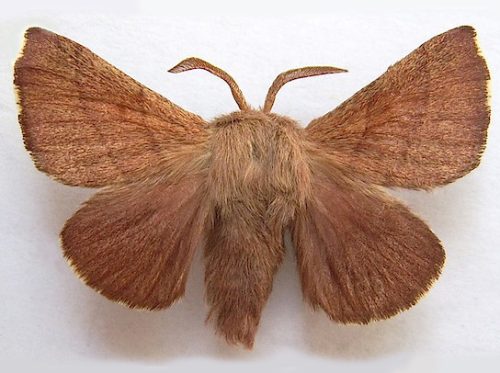
Wingspans range from 1.75 to 1.75 inches in the Forest Tent Caterpillar Moth (Malacosoma disstria). With parallel dark lines that occasionally form a single band, their wings are colored yellow, tan, or buff-brown. Their populations do not decline over 4-6 years, but they do experience a surge every 6-16 years. Adults group together near lights during outbreaks and are active in July. They have a ten-day lifespan. Instead of making actual tents, they, in contrast to others, weave silk mats onto tree trunks or branches.
American Dagger Moth
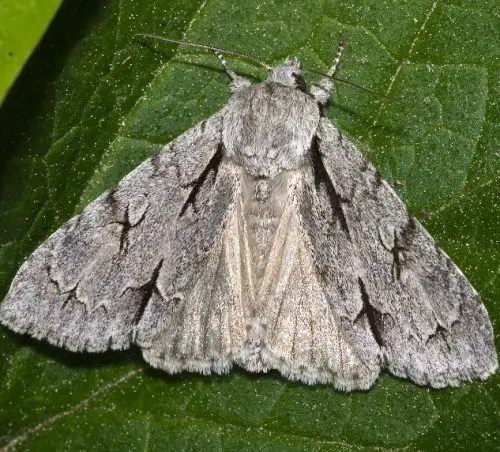
With its fine grayish-white hair and intricate black and white patterns, the American Dagger (Acronicta americana) is the largest dagger moth in California. They live in forests, swamps, parks, and backyards, with a preference for deciduous trees. Southern populations may produce two or three offspring annually, whereas populations in the north only produce one. In April through September, look for active adults; in July through October, look for caterpillars. The wingspans of adults are 2-2.6 in (5-6.6 cm).
Green Cloverworm Moth
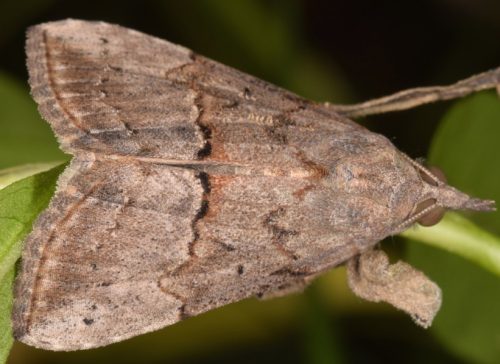
In gardens, fields, and along the edges of woodlands, the Green Cloverworm Moth (Hypena scabra) is a tiny, inconspicuous moth that is frequently spotted close to outdoor lights. Vegetables can suffer significant harm from their larval form. With multiple annual broods, they are visible all year round in warmer climates, mostly in northern climates between March and November, and they occasionally emerge on warm days. Adults typically have wingspans between 0.98 and 1.38 inches (2.5 and 3.5 cm).
Banded Tussock Moth
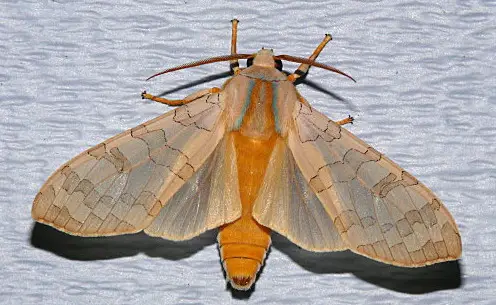
Although they are rarely seen close to outdoor lights, banded tussock moths (Halysidota tessellaris) are abundant in California’s deciduous forests. They resemble Sycamore Tussock Moths and are only differentiated by dissection or DNA analysis. They are active from May to August. Caterpillars consume a variety of plants and store chemicals for defense against predators, while adult moths feed on nectar. Adults can fly at 1.57-1.77 inches (3.8-4.3 cm) in length.
Hickory Tussock Moth
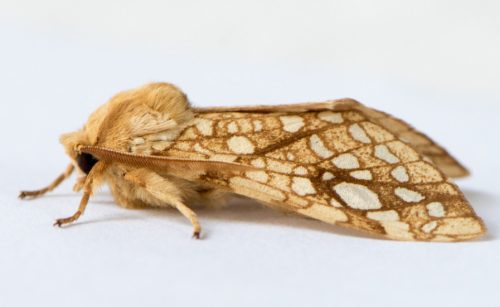
Hickory Tussock Moths (Lophocampa caryae) don’t feed as adults. They produce clusters of caterpillars and localized defoliation when they deposit their eggs in batches on leaves. Because caterpillars irritate skin, it’s best to keep them in their cocoons. The wingspan of an adult is 1.46-2.17 inches (3.7-5.5 cm).
Isabella Tiger Moth
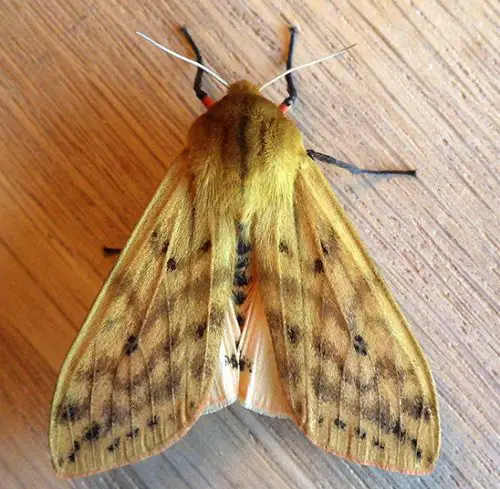
The Isabella Tiger Moth, or Pyrrharctia Isabella, can survive in a variety of environments across California, including the Arctic. They can survive in subfreezing temperatures thanks to their special cryoprotectant production. Their short life span is used to ward off predators by vibrating a tymbal organ and producing high-frequency clicks. Easily identified as Wooly Bears, or caterpillars, their band patterns have sparked a folktale regarding the forecasting of winter. An adult’s wingspan is 1.75–2.5 inches (4-6 cm).
Spotted Tussock Moth
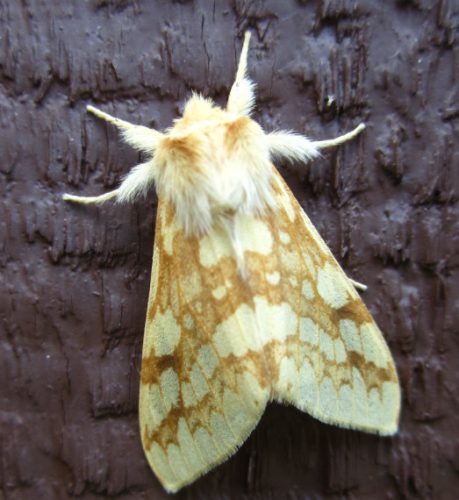
The wingspans of the Spotted Tussock Moth (Lophocampa maculata) range from 1.38 to 1.69. Their hindwings are cream, and their forewings, which are yellow or tan, have brown stripes. They have a cream or tan furry body and exhibit polymorphic color variations. Their caterpillars spend two months feeding in the deciduous forests of California before pupating in brown silk cocoons attached to leaves in preparation for winter emergence.
Large Yellow Underwing
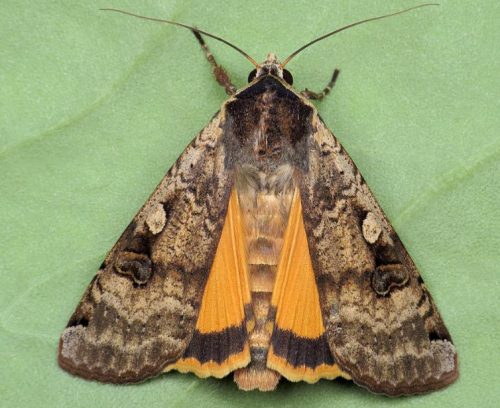
With brown forewings and yellow-orange hindwings, the Large Yellow Underwing (Noctua pronuba) has wingspans of 1.57–2.36, measuring approximately. They can adapt to a wide range of habitats, and during takeoff, their sudden bursts of color frighten predators. They thrive in a variety of settings, including parks, fields, and urban areas. They are attracted to outdoor lights. They only have one generation per year, but they live for a long 55–75 days.
Carolina Sphinx
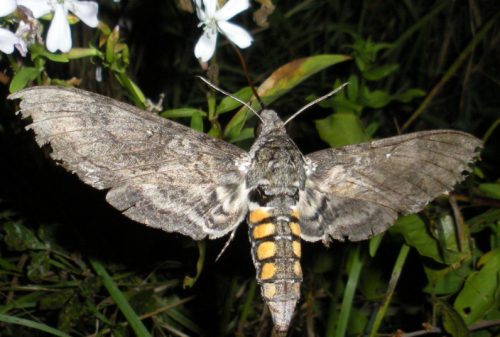
The Carolina Sphinx, or Manduca sexta, has wingspans of 3.75 to 4.75 and is renowned for hovering close to tubular flowers that are rich in nectar. Their Tobacco Hornworm caterpillars are excellent pollinators, but they also wreak havoc on crops like peppers and tomatoes. They have several broods all year round in warmer climates, but between May and October in colder climates, adults emerge with two broods. They overwinter as pupae and lay up to 1,000 eggs.
Salt Marsh Moth
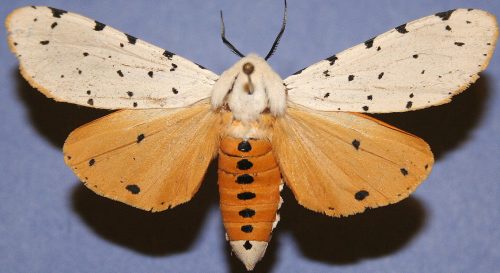
With wingspans of 1.75 to 2.69 inches and white forewings and orange hindwings in males and white in females, the Salt Marsh Moth (Estigmene acrea) is a unique insect. Their caterpillars are infamous agricultural pests that prey on crops like corn, tomatoes, and cotton despite their pretty appearance. They have one to four broods a year and are active from May to August. They use silk parachutes to escape potential threats.
Imperial Moth
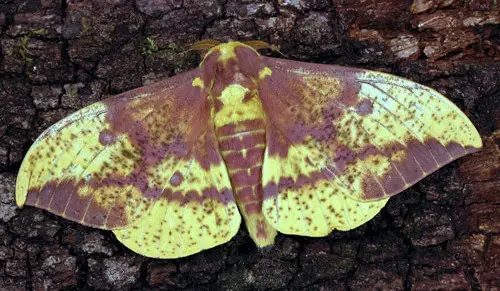
One of the biggest moths in California is the Imperial Moth (Eacles imperialis), which has wingspans of 3.13-6.88 and eye-catching, variable-colored patterns. Their caterpillars are orange in color and eventually turn brown, burgundy, or green with protective spines. They can be found in a variety of habitats. They only have one brood per year, and factors like pesticides, light pollution, and parasitic Tachinid flies are causing their population to decline.
Io Moth
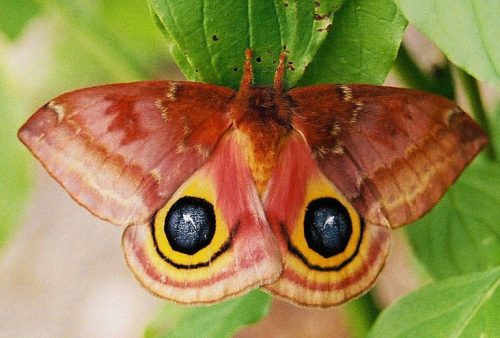
The striking yellow or reddish-brown/purple bodies, large feathery antennae, and captivating hindwing eyespots of the 2.5–3.5 in wingspans that characterize Io Moths (Automeris io) found in California. They use these eyespots as a defense mechanism to startle predators. They are nocturnal creatures that cease to eat as adults, being active from May to June in the north and from February to September in the south. Always be on the lookout for their poisonous spines.
Hummingbird Clearwing
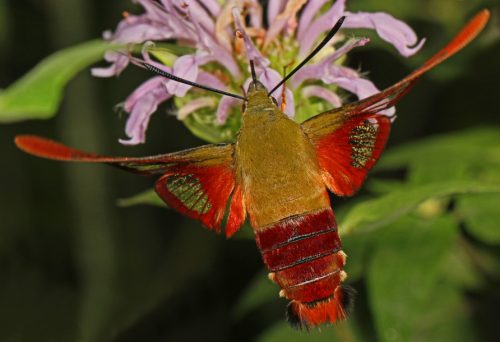
Hemaris thysbe, also known as Hummingbird Clearwings, are tiny hummingbird-like birds that hover over pink or purple flowers to feed. During the day, they are active and produce a gentle buzzing sound as their wings move quickly and clearly. Females lay green eggs that hatch after a week for one or two annual broods. Caterpillars feed for approximately four weeks before hibernating in leaf litter cocoons and emerging in the spring. Their wingspan measures 1.6-2.2 in (4-5.6 cm).
Fall Webworm Moth
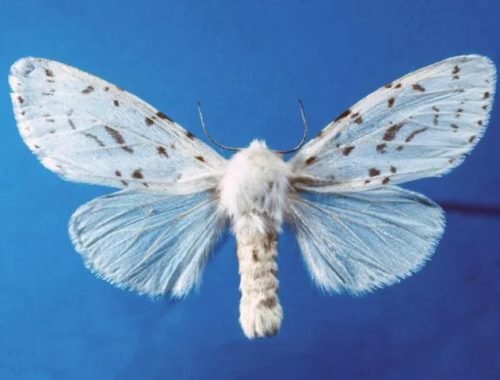
Hyphantria cunea, also known as the Fall Webworm Moth, has 1.4–1.7 wingspans, white forewings, and a hairy, white body with sporadic orange markings. While they are feeding on different hardwood trees, caterpillars have been observed to erect protective tents. In California, they are active from April to September and can have one or more broods a year. The females lay large masses of iridescent green eggs. Before emerging in the spring, the last brood overwinters as brown cocoons in leaf litter.
Ailanthus Webworm Moth
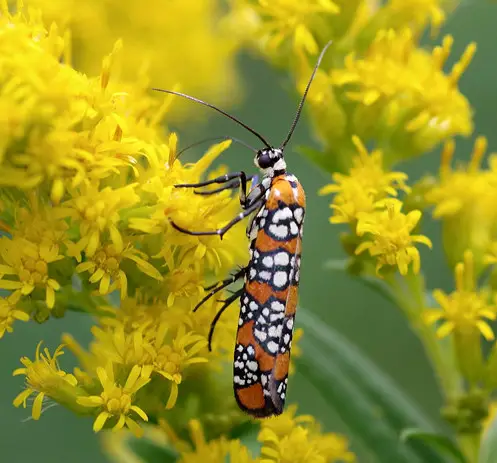
In California, populations of Ailanthus Webworm Moths (Atteva aurea) differ in size of their yellow spots according to their geographic location. They have quick life cycles; in four weeks, they go from eggs to adults. By consuming nectar from flowers and chemicals from the tree of heaven, they pollinate and deter predators with their vivid colors. Before the final brood begins breeding in the spring, they overwinters as eggs. Their impressive wingspan is 0.5-1.18 in (1.3-3 cm).
Polyphemus Moth
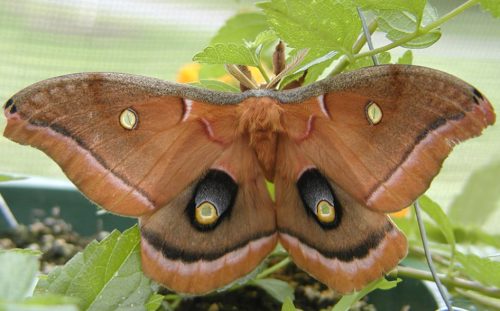
An intimidating feature of the Polyphemus Moth (Antheraea polyphemus) is its large, intimidating eyespots that resemble the face of a great horned owl. They can be found in many different habitats in California, and as adults they only live for about four days. Because both sexes are solely focused on mating, they do not need food. Instead, males use their feathered antennae to detect females using pheromones. Wingspans in adults are 4-6 in (10-15 cm).
Milkweed Tussock Moth
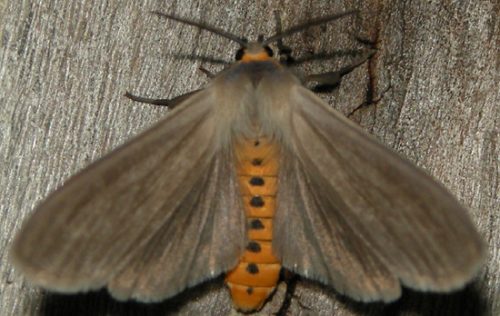
Although the adults of the Milkweed Tussock Moth (Euchaetes egle) may appear uninteresting, their bright caterpillars have tufts of black, white, orange, and yellow. By storing plant chemicals and making warning clicks to scare off bats, they ward off predators. They live alongside monarch butterflies and act as natural pollinators for milkweed plants. The range of wingspans is 3.4-5.3 cm (1.25-1.7 inches).
Virginian Tiger Moth
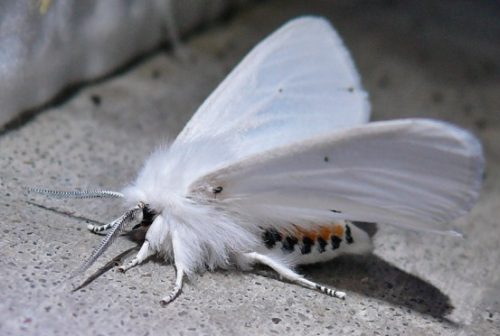
The Virginian Tiger Moth (Spilosoma virginica) is a species that lives well in a variety of environments in California, such as farms, grasslands, forests, and urban areas. Males identify female pheromones with their characteristic feathery antennae, which is how they communicate. Having several broods a year, the final brood overwinters as caterpillars. The range of wingspans is 1.25 to 2 inches (3-5 cm).
Giant Leopard Moth
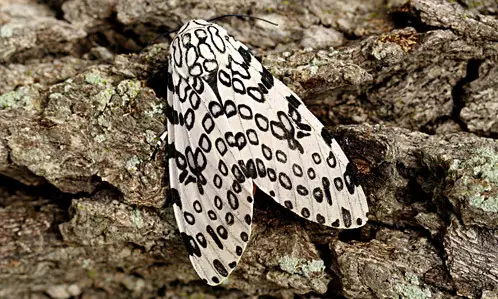
The Hypercompe scribonia, or giant leopard moth, gets its name from its eye-catching patterns resembling leopards. They can detect and ward off predators, including bats, thanks to their large ears and tymbal organs. These moths are further protected by secreting a bitter fluid and feigning death. Adults have wingspans ranging from 5.7-8.9 cm (2.24-3.58 inches).
People Who Read This Also Read:

